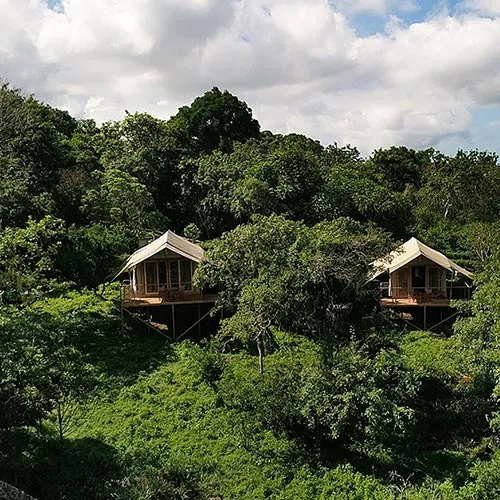North Seymour: At a glance
- Uninhabited (by humans)
- 1.9 squared km / 0.73 squared miles
- Located just north of Baltra Island (the airport island that serves Santa Cruz)
- Boat trip: 40 minutes to 1 hour each way
- Walking rating: Easy
- The island resulted from a landmass that rose up from the sea due to tectonic uplifting
- Encounter mesmerizing birdlife on the uninhabited island of North Seymour.
- Explore the secluded beach of Las Bachas and its surrounding waters.
North Seymour is one of the four uninhabited islands guests can choose to visit on our Safari tours. The other options include Bartolome, South Plaza and Santa Fe (Read more; Galapagos Islands to Visit)
Sat just north of Baltra (the airport) Island, North Seymour is one of the closest uninhabited islands to Santa Cruz and easy to reach by boat.
Our North Seymour Tour
After transferring by car from Galapagos Safari Camp to Itabaca Channel (Santa Cruz’s northern port), you will board a boat (either shared or private) to take you firstly to North Seymour for a guided tour of the island, and then on to Bachas beach on Santa Cruz’ northern coastline for a snorkel.
Birds galore!
What makes North Seymour special is its populations of birds. Many a seabird has decided that this particular rocky islet is ideal, a true place to call home.
Frigatebirds
The island is particularly famous for its gallant frigatebirds. Observed from afar in the sky, their large pointed wings can seem slightly ominous, but on land, during mating season, these black-feathered birds become some of the most awe-inspiring visions. The courting male inflates his guttural pouch into an enormous scarlet-red balloon.
Blue-footed boobies
The island is also renowned for its colonies of blue-footed boobies, who, despite looking somewhat gormless are in fact some of nature’s most impressive divers. And dancers. Mating pairs perform wonderfully intricate courtship dances here, hooting, honking, whistling, shuffling, ‘sky-pointing’ and basically showing off their skills, health and desirability to each other.
Dwarf Palo Santo trees
Your Safari tour follows a flat trail around the western side of the island, cutting through a forest of Dwarf Palo Santo trees and past nesting colonies of boobies and frigates. Breeding for both frigates and boobies is opportunistic and can take place at any time of year, usually when there is an abundant food supply.
Land Iguanas
View this post on Instagram
Being a relatively small island, your chances of seeing a Land Iguana on North Seymour are generally quite good. These prehistoric looking reptiles are usually found within the dry interior of the island, basking in the sun or grazing on cacti.
Sea Lions
View this post on Instagram
The final stretch on the island’s circuit trail runs alongside the stoney beach of North Seymour. Here you may well encounter a sea lion or two snoozing on rocks or feeding their young.
Bachas Beach
Lunch is served on board the boat during the navigation to Bachas beach, on the northern coast of Santa Cruz Island.
This pristine stretch of white sand is only accessible by sea and is a nesting ground for Galapagos green turtles during the breeding season. Mating usually takes place in November and December. The females come ashore to lay their eggs at night from December to June, and the eggs incubate for about 60 days. To avoid being eaten, the hatchlings usually make their dash to the water at night.
Your visit begins with a guided tour along the beach to a brackish lagoon where flamingoes are sometimes spotted. Look out for the partially hidden remnants of a WWII barge ship, left behind by the American army.
After your tour, you can explore the shallow, warm waters of Bachas bay, before the return boat ride to Itabaca Channel.
Fauna to look out for:
Great frigatebird; Magnificent frigatebird; Blue-footed booby; Nazca booby; Red-footed booby (occasionally seen, although it does not nest here); Brown pelican; Swallow-tailed gull; Lava gull; Common noddy; Waders; Ground finch; Land iguana; Lava lizard; Striped; Galapagos snake; Marine iguana; Galapagos sea lion; Sally lightfoot crab
Flora to look out for:
Dwarf Palo Santo; Parkinsonia; Prickly Pear Cactus; Muyuyu; Leatherleaf; Saltbush; Spiny bush; Galapagos carpetweed; Sea purslane; Galapagos Croton; Hairy morning glory; Hairy ground cherry; Puncture weed.
Galapagos Islands to Visit
To learn more about the other islands we visit, see our guides below:
Plan your Galapagos Vacation
See our suggested Galapagos itineraries and recommended activities.
Disclaimer: As with any wildlife holiday experience, we cannot guarantee that you will see each of the species mentioned in this article. Instead, please view this information as a guide, based on the first-hand experience of our expert naturalists and guests at Galapagos Safari Camp.
